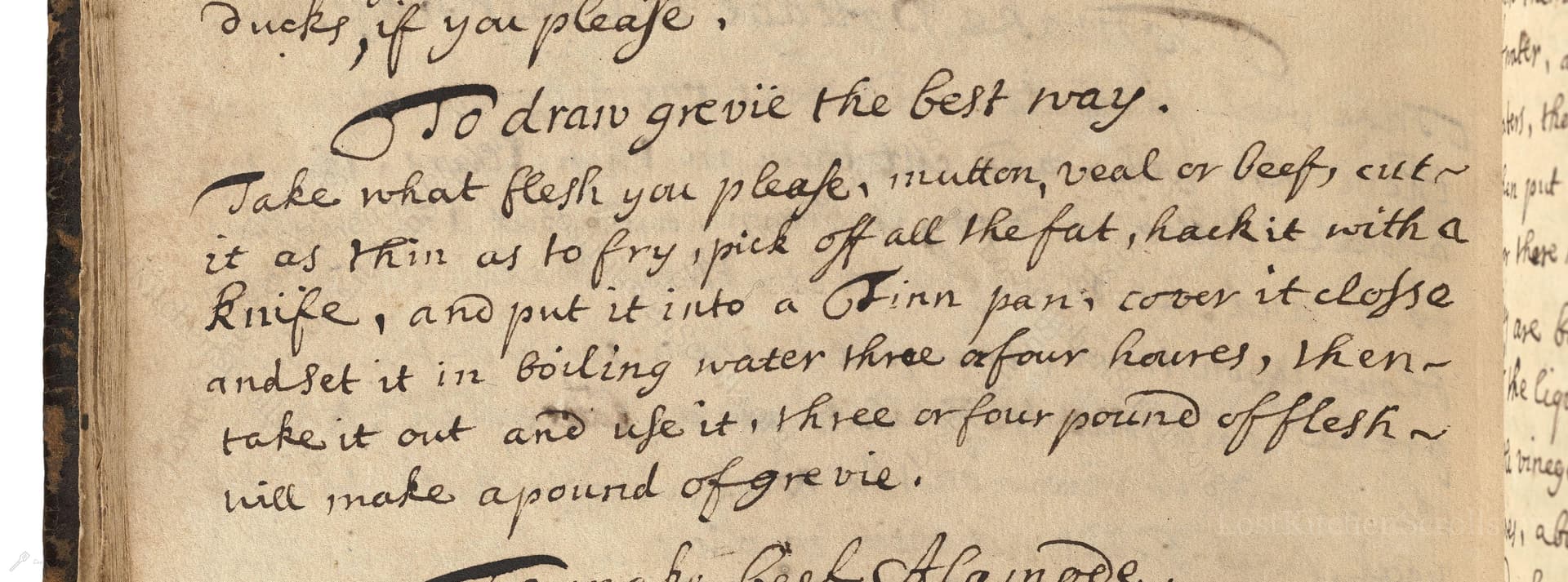To Draw Grevie The Best Way
From the treasured pages of Cookbook
Unknown Author

To Draw Grevie The Best Way
"Take what flesh you please, mutton, veal or beef, cut it as thin as to fry, pick of all the fat, hack it with a knife, and put it into a Finn pan, cover it close and set it in boiling water three or four houres, then take it out and use it, three or four pound of flesh will make a pound of grevie."
Note on the Original Text
Spelling in the recipe is variable—'grevie' for 'gravy', and 'Finn pan' possibly referring to a fine or thin pan used for extracting juices. The instructions prioritize the technique (thin slicing, hacking, moist gentle heat) but lack measured seasoning or precise amounts, reflecting the period’s reliance on cook’s judgment rather than standardized measurements. The language is pragmatic, presuming familiarity with hearth cooking methods and resourcefulness with available kitchen tools.

Title
Cookbook (1706)
You can also click the book image above to peruse the original tome
Writer
Unknown
Era
1706
Publisher
Unknown
Background
Step back to the early 18th century with this charming culinary collection, brimming with period recipes that tantalize the tastebuds and offer a delicious glimpse into historic kitchens.
Kindly made available by
Folger Shakespeare Library
This recipe emerges from early 18th-century Britain, around 1706, during a time when gravies or 'essences' of meat were prized for both culinary and medicinal purposes. 'To draw grevie' refers to extracting the concentrated juices from meat, serving as a base for sauces and stews before the advent of ready-made stocks or bouillons. Such methods were foundational in upper-class and professional kitchens, revealing a sophisticated approach to maximizing flavor from simple ingredients.

Originally, cooks would have used a 'Finn pan'—likely a deep, lidded metal pan suited for gentle simmering—placed within a larger vessel of boiling water, a method akin to a bain-marie or double boiler. A long-handled knife or cleaver would be used to hack the meat, with a trivet or hearth for maintaining steady heat over several hours. The setup allowed for low, moist heat without burning the meat, essential for drawing out the 'grevie'.
Prep Time
20 mins
Cook Time
4 hrs
Servings
6
We've done our best to adapt this historical recipe for modern kitchens, but some details may still need refinement. We warmly welcome feedback from fellow cooks and culinary historians — your insights support the entire community!
Ingredients
- 3 to 4 pounds (1.5 kg) mutton, veal, or beef (choose one or a mix)
- No added fat (remove all visible fat from the meat)
- No salt or seasoning specified—season to taste if desired
Instructions
- Begin by selecting your preferred meat: mutton, veal, or beef—about 3 to 4 pounds (roughly 1.5 kilograms).
- Slice the meat thinly, as if for stir-frying, and carefully remove all visible fat.
- Give the slices a good hacking with a sharp knife to break up fibers, making the meat more able to release its juices.
- Place the prepared meat in a large, lidded saucepan or Dutch oven, then cover tightly to minimize evaporation.
- Set the pan into or over a larger pot of boiling water (a modern double boiler setup), ensuring indirect, gentle heat.
- Maintain a very gentle simmer for 3-4 hours—the goal is slow extraction, not harsh boiling.
- When done, you'll be left with a concentrated essence—your 'grevie' or gravy.
- This yields about 1 pound (450 grams) from 3 to 4 pounds of meat.
- Strain and use wherever a rich meat jus or gravy is required.
Estimated Calories
60 per serving
Cooking Estimates
Allow about 20 minutes to slice and prepare the meat, then about 3 to 4 hours to gently cook it until you get a concentrated, flavorful gravy. This recipe makes about 450 grams (1 pound) of gravy, which serves around 6 people at a typical portion size. Each serving is low in calories because all visible fat is removed and no additional fat is added.
As noted above, we have made our best effort to translate and adapt this historical recipe for modern kitchens, taking into account ingredients nowadays, cooking techniques, measurements, and so on. However, historical recipes often contain assumptions that require interpretation.
We'd love for anyone to help improve these adaptations. Community contributions are highly welcome. If you have suggestions, corrections, or cooking tips based on your experience with this recipe, please share them below.
Join the Discussion
Rate This Recipe
Dietary Preference
Main Ingredients
Culinary Technique
Occasions

Den Bockfisch In Einer Fleisch Suppen Zu Kochen
This recipe hails from a German manuscript cookbook compiled in 1696, a time whe...

Die Grieß Nudlen Zumachen
This recipe comes from a rather mysterious manuscript cookbook, penned anonymous...

Ein Boudain
This recipe comes from an anonymous German-language manuscript cookbook from 169...

Ein Gesaltzen Citroni
This recipe, dating from 1696, comes from an extensive anonymous German cookbook...
Browse our complete collection of time-honored recipes



